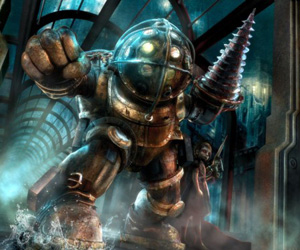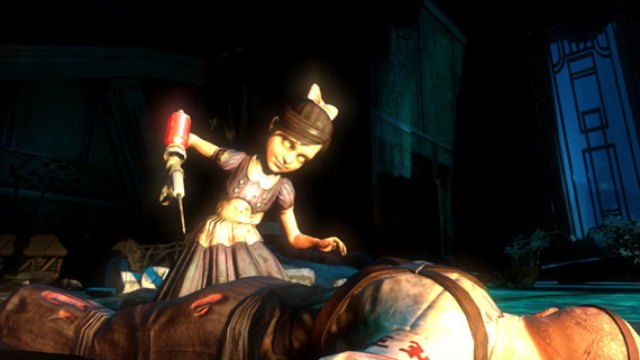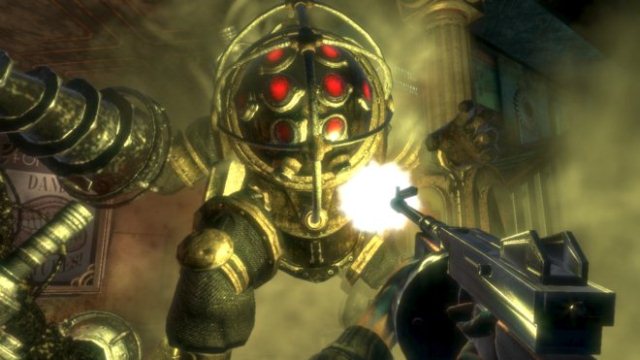A Look Back On… BioShock
 The best video game stories are the ones that stick with you long after you’re done, the ones that creep back into your consciousness after months of playing other games, the ones that you see tiny elements of in subsequent titles and suddenly wish you were playing instead. If I’m dead honest, 2K Boston’s 2007 shooter BioShock wasn’t one of those games – not right away.
The best video game stories are the ones that stick with you long after you’re done, the ones that creep back into your consciousness after months of playing other games, the ones that you see tiny elements of in subsequent titles and suddenly wish you were playing instead. If I’m dead honest, 2K Boston’s 2007 shooter BioShock wasn’t one of those games – not right away.
The moment when BioShock grabbed hold of me, when it really sunk its harpoons into my resistant flesh, actually came several hours in. The first time I had hold of a frightened eight year old girl in one hand and a rusty nine-inch syringe in the other and I was forced to make a choice…
But we’ll come back to that. First, what is this BioShock of which I speak? To be perfectly fair to you, if you don’t know what BioShock is then you’ve either been living in a cave with a solar-powered Mega Drive for way too long or you’ve wandered onto the wrong site, however, for the sake of completion I’ll sum it up for you briefly.
BioShock is set in a retro-futuristic version of 1960, a world where the greatest minds of science and medicine have grown weary of society’s constraints, disillusioned by what they consider to be restrictions forced upon them by the simple, primitive concept of morality. Ultimately, such hubris led them to build Rapture, a vast underwater city where they were free to stretch, even break, the boundaries of modern science.

The discovery of a rare sea-slug led to the harvesting of a plasmid known as ADAM, a substance able to alter human DNA and grant superhuman, even extra-sensory, powers. The founder of Rapture, magnate Andrew Ryan, controlled the source of ADAM and by extension the entire city, until such power led irrevocably to civil calamity. Stirred up by former gangster Frank Fontaine, Rapture’s lower classes spiralled into rebellion when Fontaine and genetecist Brigid Tenenbaum began to manufacture cheap plasmids, and found a way to mass produce ADAM by growing it inside orphaned girls known as Little Sisters.
The war was long and bloody, as Ryan created ADAM-enhanced soldiers called Splicers and set about eradicating Fontaine’s rebels. After Fontaine’s death, Ryan seized the factories making Little Sisters and created Big Daddies, enhanced humans encased in massive diving suits, to protect them from a new enemy, an individual known as Atlas who, on New Year’s Eve 1959, ordered a full-on assault on Ryan culminating in the complete disintegration of order in Rapture.
Which is where you come in. You play Jack, survivor of a plane crash in the sea over Rapture, drawn into the conflict by what appears to be a series of random events but is far more sinister. From that opening plane crash, bobbing on choppy, burning waves beneath a slate black sky, it was clear that BioShock would be special, and it went on to surpass itself repeatedly for its entire duration.

Rapture herself is as big a character as Jack, or Ryan, or Tenenbaum; a world unique in her aesthetics and backstory, not alive like Liberty City or even Fallout 3’s Wasteland, but dead and festering, still riddled with the same human cancer that destroyed her and that continues to gnaw at her. Insane splicers skitter, spider-like, through shadows cast by neon lights and flickering chemical fires; Big Daddies roam the decaying corridors, willing to die or kill to protect their Little Sisters; and thrust into the middle, Jack, a buoy in a maelstrom, a lost lamb in a slaughterhouse.
Splicers alone are creepy enough, but the first time you run into a Big Daddy, huge, ponderous, determined, deadly, the moment is accompanied by a genuine sense of dread. Avoid the harpoon gun and great rusted drill-arm and put him down, and you’ll find yourself on the threshold of that moment I mentioned in the intro, poised with your hand around a Little Sister’s wrist, faced with a decision, a simple choice: End the wretched creature’s misery and harvest all the ADAM within her, or take just a portion, and free her from her curse? That first time was the moment that, for me, BioShock stopped being a first person shooter and became a quest to free these little girls, all of them, and to put an end to the malignant evil picking at Rapture’s wilting corpse. I became empowered, not only by the plasmids afforded me by harvesting ADAM, but by my new-found determination.
Guided by both Atlas and Dr. Tenenbaum, Jack goes from place to place seeking Ryan, and when he finds him the game flips everything on its head when you realise that Jack’s actions, and your own, have been dictated by Atlas – revealed to be Fontaine – and the code word drummed into your mind since he took you away from Rapture at birth: “Would You Kindly…”. It’s only at that moment you realise it’s been happening and you’ve been allowing it to, just by playing the game. It’s genius. Actual genius.

Elsewhere, BioShock makes strong arguments for the “video games as art” debate; the steampunk-deco art style and strength of its story and themes elevate it above the level of a common shooter. It riffs heavily off of Ayn Rand’s Atlus Shrugged, a sci-fi novel written in 1957 that examined what might become of society if the intellects that drove the world to progress went on strike. Themes of objectivism and our detrimental reliance upon technology and those that perpetuate it are rife in BioShock’s dark world, but flipped, so that instead of those “men of the mind” going on strike they’ve gone into overdrive, locked away in a powder keg of possibilities.
Although BioShock’s final ten minutes degenerate into a fairly lame boss fight with an ADAM-charged Fontaine, the gameplay up to that point is largely flawless. Utilising a now popular dual-hand system to allow you to combine melee, ranged and plasmid attacks separately, combat is exhilarating and tense; especially during that first Big Daddy encounter. The plasmids themselves are analogous to magical attacks in other games, featuring the holy triumvirate of ice, fire and lightning as well as abilities that confuse your foes or unleash swarms of killer bees from beneath your flesh. They have environmental uses, too, like clearing ice from your path or turning a harmless puddle into a deadly trap with a fork of lightning. The options are impressive, even if the Vita-Life Chambers that facilitate your resurrections are positioned close enough together that they rob a good deal of BioShock’s challenge.

Slight balancing issues notwithstanding, the gameplay is more than enough to drive you on through an exceptional narrative that keeps on giving whether you choose to take my altruistic path or opt to simply harvest every Little Sister for the maximum amount of ADAM. The lack of multiplayer is never a problem, even though 2K Marin saw fit to add it to the less well-recieved 2010 sequel.
Though the upcoming third instalment, BioShock Infinite, leaves Rapture behind to ride the clouds upon the flying city of Columbia, the themes of objectivism remain. I can only hope that Irrational Games (as 2K Boston is now known), stay faithful to the balance of style and substance they struck with BioShock.




